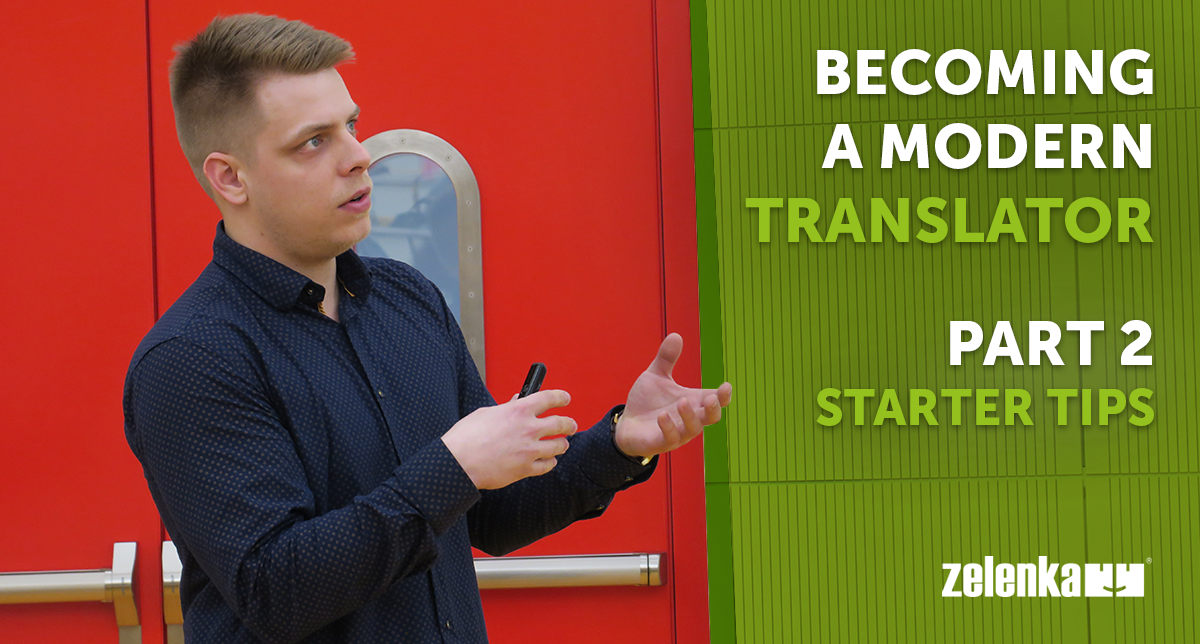Becoming a Modern Translator, Part 2 – Starter Tips

Lukáš Matlak
4. 6. 2019
Now that we know what the current situation is for translators out there, let’s have a look at some points that may really help you find your footing in the field.
Having gone through that process myself, I’ve put together a list of points that I feel are crucial when trying to start your career as a modern translator. Despite the number of technologies in the game, there are still many things you can do to add to your own success.
1. START WORKING DURING YOUR STUDIES
Freelancing in this industry means you are not only a translator, you are your own manager, sales representative and in most cases accountant too. Time management and soft skills are crucial as well. With all of this (and more) to manage and learn, getting your career started during your studies can give you a strong advantage on the market. Plus, as a student, the extra money definitely comes in handy.
2. EXPECT “MINI JOBS” IN THE BEGINNING
The start will be slow. Be ready for it and don’t let it discourage you. Most likely the very first jobs you receive will be super-urgent, tiny bits with a deadline of “yesterday is too late”. In these situations, readiness is key. Helping clients in emergencies can help build up your reputation pretty quickly. On the other hand, don’t push yourself to take jobs you don’t feel comfortable with — it may do more harm than good.
3. KNOW HOW TO WORK IN DIFFERENT CAT TOOLS
CAT tools are essential, regardless of if you translate for a living or part-time to make some extra money. Even though there are many different products out there these days, they all essentially do exactly the same thing. Once you understand the basics and learn how to use some of them, you should be able to easily switch between them without too much trouble.
“Why would I spend the money for different products that do the same thing,” you’re asking? Each product has its strengths and weaknesses, pros and cons. These typically play a primary role in choosing a solution for a specific project, but from the translators’ perspective, the differences are usually only cosmetic.
4. MAKE SMALL INVESTMENTS
Speaking of tooling, the good news is that you may not have to invest a lot of money into it. Most translation companies have licenses to lend you in order to work on a specific project. Additionally, with the growing popularity of cloud-based solutions, all you need is a URL and credentials from the company and you’re ready to start working. If these aren’t an option, be sure to make use of the free trial periods that most products offer to help you figure out which one works best for you.
5. DON’T BE AFRAID OF POST-EDITING
For a long time now, post-editing has been presented as the boogieman of any translator. And I do understand why – PE is a reality, not the future. It is here and is changing the traditional way work. On the other hand, I believe the fear is only a result of lack of information and training, on both sides – linguists and companies.
There are plenty of guides out there on how to post-edit, and some are better than others. At any rate, keep moving forward and you’re sure to find your way through it. Even if the MT hit does not provide you with a perfect translation, it might help you understand the source more quickly and immediately provide certain lexical items you might otherwise spend time searching for, thinking about or trying to come up with.
The primary benefit of machine translation, as I see it, is not to exterminate the role of humans in translation, but rather to make their work and lives easier. And recent developments and improvements in the field are starting to bring the desired results.
Good MT allows you to double the amount of content you are able to process. This shift isn’t unilateral, however — MT remains unsuitable for some types of text. For instance, while it may greatly increase your speed and effectiveness in translating a legal or technical text, it may do more harm than good when working with marketing texts and other content that relies heavily on creativity. Companies still have a lot to learn about getting the most out of MT, but the time is coming when it becomes a major benefit for everyone involved.
6. EMBRACE FEEDBACK
Once you put yourself on the market, you’ll have endless opportunities to develop and learn new things. This applies not only to the texts you’ll be translating, but also to the feedback you get from the people you work for. In fact, feedback is one of the very few ways to accurately appraise your work. With that in mind, welcome every piece of feedback with respect and think critically about how you can use it to improve.
While this list isn’t exhaustive and there may even be some exceptions, I believe the tips mentioned above are powerful ways to get you started out right as a translator, especially if you approach them with passion.
If I should share one final piece of advice to aspiring fellow colleagues it would be:
The difference between a “good” product which meets the standard requirements and a perfect translation lies completely in the little details. So,
PAY ATTENTION TO DETAIL AND MAKE THAT DIFFERENCE.
Then you’ll be on track to becoming a successful modern translator.


